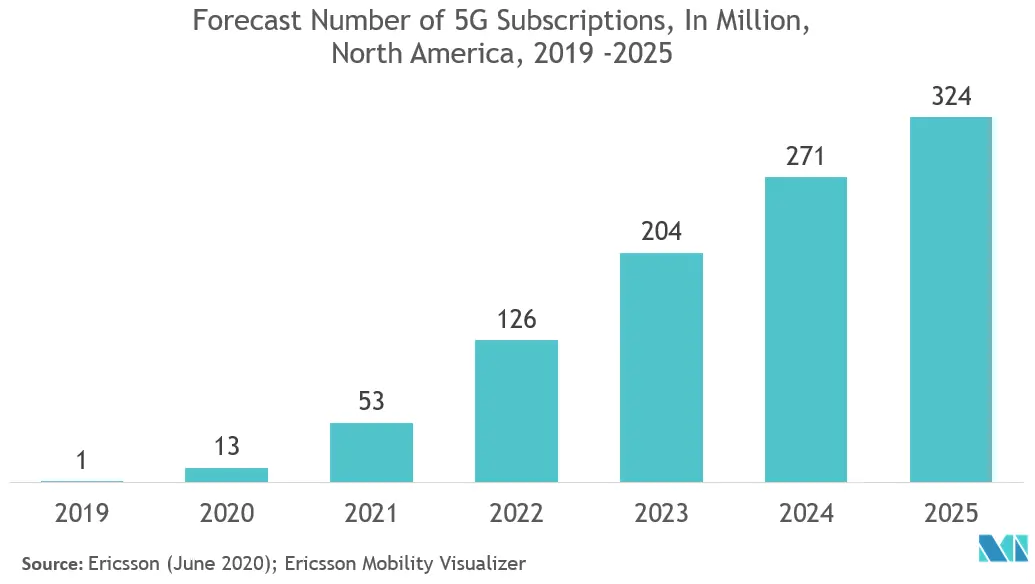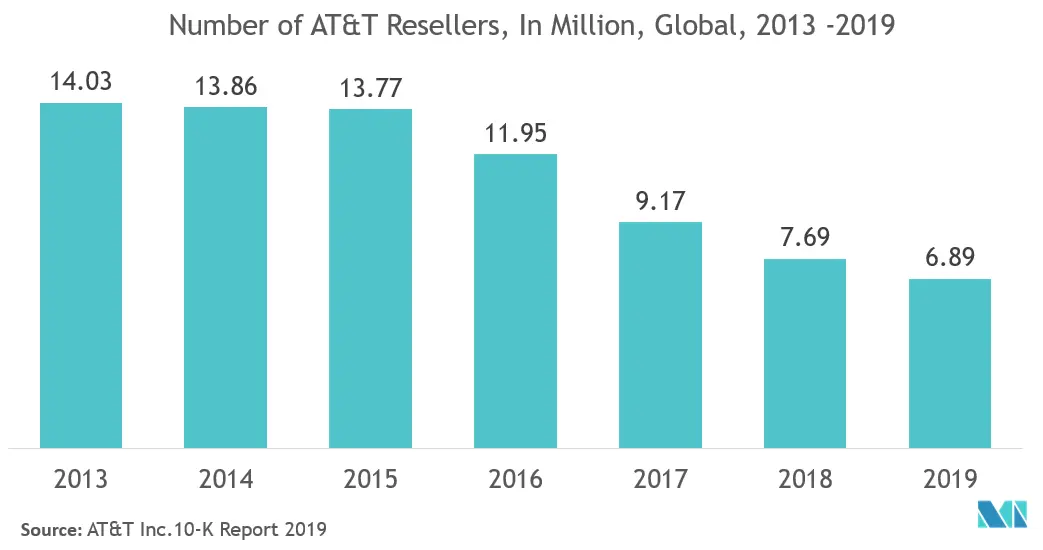Market Trends of United States Mobile Virtual Network Operator (MVNO) Industry
This section covers the major market trends shaping the US Mobile Virtual Network Operator Market according to our research experts:
Rising Demand for Efficient Cellular Network is Expected to Drive the Market
- The rising demand for an efficient cellular network is a significant factor driving the need for MVNOs in the market. Growing internet and smartphone penetration and the need for high speed around the globe, are forcing customers to opt for the most efficient network operator. The growing number of connected devices, machine to machine communication, cloud, IoT, Industry 4.0 and edge computing, among others, are some of the market trends that are making it necessary to adopt high speed and efficient networks. Also, factors such as the increasing use of advanced devices and increasing network speed have led to high growth in the use of data applications such as video streaming and internet browsing in the United States.
- Owing to the digital transformation in the United States, its is expected that MVNOs would target IoT and machine-to-machine (M2M) and connectivity. These providers would aid in expanding out-of-the-box connectivity bundled in with devices and other services in the everything connected world: vehicles, medical devices, wearables, industrial equipment, etc. The data transmitted during the M2M connection is very low due to which the IoT device providers tend to prefer operators who could provide attractive pricing and packages. MVNOs, due to their business model, are best suited to serve this industry and will further increase their penetration in this segment in the future.
- The United States is witnessing a significant rise in connected devices. Network operators such as AT&T and T Mobile in their annual reports mentioned vital subscribers to these devices. AT&T reported 30% of its total subscribers in 2018 were for the connected devices. The country has seen the highest penetration of these connected devices in recent years and holds a considerable chunk in the North American market for the number of IoT devices. According to the GSMA, the number of IoT connections in North America is expected to grow to 5.9 billion by 2025. According to the American Tower Corporation, in 2019, there were an estimated 815 million mobile-connected devices in the United States.
- According to Ericsson, the number of 5G subscriptions in North America is expected to increase from 1 million in 2019 to 324 million in 2025. Based on a virtualized infrastructure, 5G offers the ability to ‘slice’ the network and assign each part a specific quality of service, to fit a use case. The rising penetration of 4G, 4G+, and 5G technology will also transform the business models of mobile operators and MVNOs. Features like network slicing will allow MNVOs to run ‘mini-networks,’ for customers in specific sectors. This offers the ability to target several vertical markets and applications, opening up opportunities for MVNOs. For instance, an MVNO-run branded mobile network for gaming requires lower latency and higher bandwidth. Network slicing will be beneficial for this.

Resellers are Expected to Hold Significant Share
- Resellers are the third-party arrangement, selling a provider/operator's services and piggybacking a standard service SLA. One bill is issued through the overall service provider or operator. A reseller MVNO will either operate under its brand or co-brand with the MNO. Mostly, the branded reseller brings brand distribution channels or a large existing customer base to the table, from which it can leverage its sales. The choice of an operational model for the MVNOs is highly influenced by the operators' willingness for the associated risks and the cost of operations. The business process makes the MVNO market more of a business with less capital expenditure estimated at around USD 3.5 million and peak project funding estimates in the range of USD 6 million to USD 8 million.
- Using the reseller model, an MVNO can potentially offer its value-added services (VAS). The limited liability makes this market segment associated with fewer risks for the MVNO and limits revenue opportunity, due to lack of control on operations. In this business model, the MVNOs hold no assets in the partnership with the MNO's, i.e., they get no ownership of the client, the infrastructure, or the SIM and cannot set prices. The mobile reseller is for those companies that want to provide a tailor-made mobile communication tariff to their customer base. At the same time, the branded reseller is for companies that want to enrich their brand with mobile communication services.
- The branded reseller model enables the MVNO to reap the benefits of operating under its brand or, in some instances, co-branded with the MNO. The reseller (branded) is liable for the costs of branding, sales, and distribution, and shares revenues with the partner MNO. The clients in this market belong to the MNO's. Revenue margin is estimated to lie in the range of 10-15% for the resellers. Branding, sales, and marketing are under the reseller scope, and the operational capability to handle the customer care services may be partially present or absent depending on the business agreement. Moreover, resellers take less time to market and require low startup costs, as no investment in MVNO infrastructure is needed because the network operator handles most of it. The reseller MVNO is also responsible for the costs of marketing, sales, and distribution.
- With the growing adoption of 4G and 5G technology, the reseller model is expected to have a tremendous opportunity over the forecast period. For instance, in January 2020, a new MVNO was launched to the public under Venn Mobile. The MVNO is run by the same organization of T-Mobile business plan reseller, Teltik. The plan costs USD 30 per month and comes with unlimited talk, text, data, and 50GB of mobile hotspot. The 5G wireless transformation wave continues. It impacts the wireless industry and a growing number of other sectors as well. Many MVNO players like Google Fi, Xfinity Mobile, Spectrum Mobile, Altice Mobile, Tracfone, StraightTalk, and many smaller companies are continuing with intense usage, which implies a significant growth going forward.


